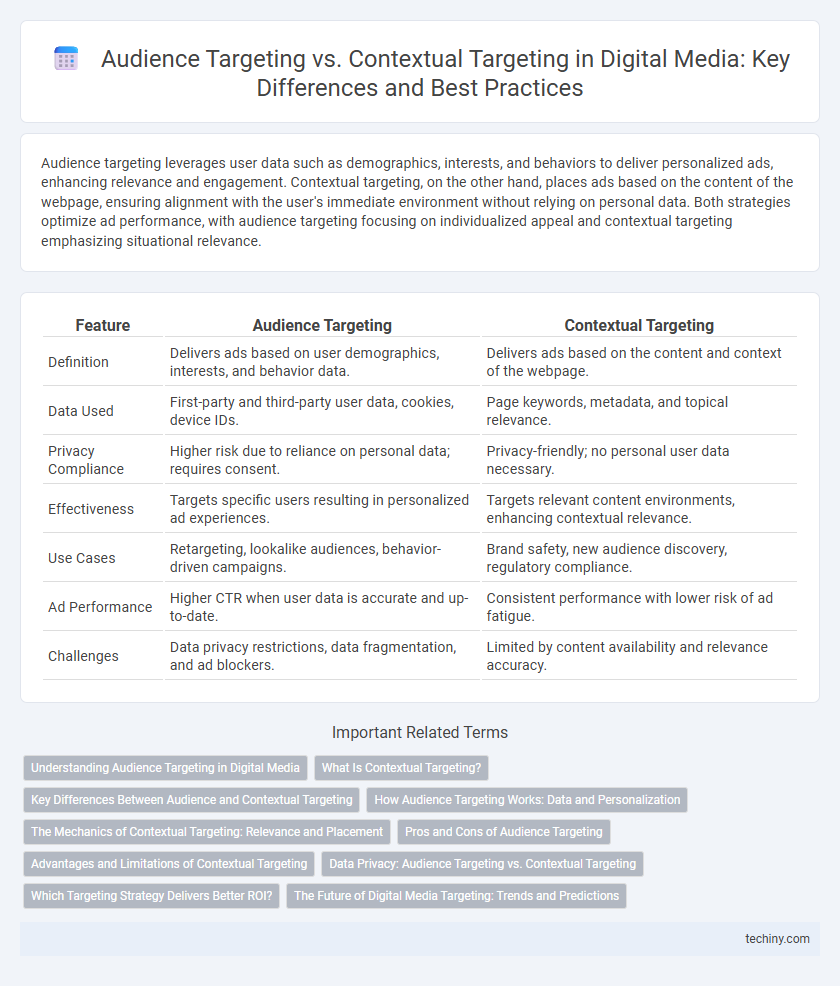Audience targeting leverages user data such as demographics, interests, and behaviors to deliver personalized ads, enhancing relevance and engagement. Contextual targeting, on the other hand, places ads based on the content of the webpage, ensuring alignment with the user's immediate environment without relying on personal data. Both strategies optimize ad performance, with audience targeting focusing on individualized appeal and contextual targeting emphasizing situational relevance.
Table of Comparison
| Feature | Audience Targeting | Contextual Targeting |
|---|---|---|
| Definition | Delivers ads based on user demographics, interests, and behavior data. | Delivers ads based on the content and context of the webpage. |
| Data Used | First-party and third-party user data, cookies, device IDs. | Page keywords, metadata, and topical relevance. |
| Privacy Compliance | Higher risk due to reliance on personal data; requires consent. | Privacy-friendly; no personal user data necessary. |
| Effectiveness | Targets specific users resulting in personalized ad experiences. | Targets relevant content environments, enhancing contextual relevance. |
| Use Cases | Retargeting, lookalike audiences, behavior-driven campaigns. | Brand safety, new audience discovery, regulatory compliance. |
| Ad Performance | Higher CTR when user data is accurate and up-to-date. | Consistent performance with lower risk of ad fatigue. |
| Challenges | Data privacy restrictions, data fragmentation, and ad blockers. | Limited by content availability and relevance accuracy. |
Understanding Audience Targeting in Digital Media
Audience targeting in digital media leverages detailed data such as demographics, behavior, and interests to deliver personalized ads, increasing engagement and conversion rates. This approach utilizes tools like cookies, device IDs, and CRM data to identify and reach specific user segments across platforms. By focusing on individual user profiles rather than the content environment, audience targeting enhances the precision and effectiveness of advertising campaigns.
What Is Contextual Targeting?
Contextual targeting involves delivering ads based on the content of the webpage or digital environment a user is currently engaging with, ensuring relevance without relying on personal data. This method uses algorithms to analyze keywords, topics, and sentiment within the content to match advertisements that resonate with the user's immediate interests. By focusing on real-time context, advertisers enhance user experience and comply with increasing privacy regulations while maintaining effective audience engagement.
Key Differences Between Audience and Contextual Targeting
Audience targeting uses specific user data such as demographics, interests, and past behavior to deliver personalized ads, enhancing relevance and engagement. Contextual targeting places ads based on the content of the webpage, matching ads with relevant topics without relying on personal user information, ensuring privacy compliance. The key difference lies in data reliance: audience targeting depends on granular user profiles, while contextual targeting focuses on the environment where the ad appears.
How Audience Targeting Works: Data and Personalization
Audience targeting leverages data such as browsing behavior, demographics, and purchase history to deliver personalized ads tailored to individual user profiles. By analyzing user interactions across multiple platforms, marketers can predict preferences and optimize ad relevance for higher engagement rates. This data-driven approach enhances campaign efficiency by focusing resources on segments most likely to convert.
The Mechanics of Contextual Targeting: Relevance and Placement
Contextual targeting uses algorithms to analyze webpage content, matching ads to relevant keywords and themes to ensure precise placement. This method enhances user engagement by delivering ads tailored to the immediate context of the content, improving click-through rates and brand recall. Unlike audience targeting, which relies on user data, contextual targeting prioritizes relevance through real-time content analysis and semantic understanding.
Pros and Cons of Audience Targeting
Audience targeting in digital media allows advertisers to reach specific user segments based on demographics, behavior, and interests, increasing campaign relevance and conversion rates. However, it often relies on extensive data collection, raising privacy concerns and regulatory challenges such as GDPR and CCPA compliance. Additionally, audience targeting can lead to ad fatigue and excluding potential customers outside predefined segments, limiting reach and diversity.
Advantages and Limitations of Contextual Targeting
Contextual targeting leverages real-time content analysis to deliver ads aligned with the surrounding digital environment, enhancing relevance without relying on personal user data, which supports privacy compliance and reduces ad fatigue. Its advantage lies in maintaining user trust and brand safety by avoiding intrusive tracking, but it faces limitations due to less precise demographic targeting compared to audience targeting, potentially lowering conversion efficiency. Contextual targeting excels in environments with strict data regulations and scenarios where brand message alignment with content is critical.
Data Privacy: Audience Targeting vs. Contextual Targeting
Audience targeting relies heavily on personal data collection, raising significant data privacy concerns due to tracking cookies and user profiling. Contextual targeting, by focusing on the content environment rather than individual user data, offers a privacy-friendly alternative that aligns with stricter data protection regulations like GDPR and CCPA. This approach minimizes intrusive data use while maintaining ad relevance, making it a preferred strategy in a privacy-conscious digital media landscape.
Which Targeting Strategy Delivers Better ROI?
Audience targeting leverages user data such as demographics, behavior, and interests to deliver personalized ads, often resulting in higher engagement and conversion rates. Contextual targeting places ads based on the content of the webpage, ensuring relevance without relying on personal data, which can improve brand safety and compliance with privacy regulations. Studies show that while audience targeting can offer superior ROI through precision, contextual targeting provides more consistent performance in privacy-sensitive environments, making the best choice dependent on campaign goals and data availability.
The Future of Digital Media Targeting: Trends and Predictions
Audience targeting leverages user data and behavior to deliver personalized digital media experiences, increasingly enhanced by AI-driven analytics for precision. Contextual targeting, relying on real-time content analysis, gains momentum due to stricter privacy regulations limiting data collection. Future trends predict a hybrid approach combining both methods, optimizing engagement while respecting user privacy and improving ad relevance through advanced machine learning models.
Audience Targeting vs Contextual Targeting Infographic

 techiny.com
techiny.com